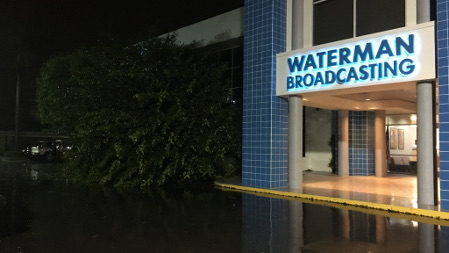Fort Myers Stations Cover Storm, Provide Refuge
FT. MEYERS & NAPLES FLA.—Two-hundred-thirty-six people, 26 dogs, numerous cats, assorted reptiles an even a colorful Macaw aren’t the typical TV staffing compliment, but Sunday, Sept. 10, was no typical day at WZVN, the Montclair Communications-owned ABC affiliate, and WBBH, the Waterman Broadcasting-owned NBC affiliate, serving Fort Myers and Naples, Fla. That’s the day Hurricane Irma came to the west coast of Florida and the stations became a refuge for the families and pets of station staff.

“Hurricane Irma wasn’t our first rodeo,” says WZVN/WBBH EVP and GM Steve Pontius. “We tell our staff to expect to be here during a hurricane but to bring a loved one.” The stations, which Waterman runs under a Local Marketing Agreement (LMA), took full advantage of the offer. “Our guests ranged in age from 87 years-old to two weeks. We had people sleeping in mechanical rooms, the conference room and hallways, and served hundreds and hundreds of meals,” he says.
The eye of the hurricane passed directly over both the studios and transmitter site of the stations, and aside from a large tree that snapped and took out a parked car and a broken water main, the building and its temporary residents emerged unscathed, says Pontius. To cover the storm, WZVN and WBBH began a local simulcast of hurricane coverage and relocated ABC and NBC network programming on their digital subchannels. The move proved to be fortuitous because both stations suffered minor service outages at different times during the storm, says Pontius. But simulcasting ensured uninterrupted local coverage.
The stations relied on the combined newsroom staffs of 110 people, including eight meteorologists, working 12 hours on and 12 hours off to provide viewers with 65 hours of continuous hurricane coverage, he said. While the studios, collocated master control rooms and newsrooms remained whole, minor problems occurred at the transmitter site when the air pressure of the storm forced open double doors and water blew into the transmitter room.

Steve Pontius
The stations rely on a primary fiber STL loop with microwave backup to transport their signals to the transmitter site. Security cameras at the site are tied in to the loop back to the station, so Pontius and the station’s engineers could see the doors as they blew open and water entered the building. Station engineers responded quickly and restored service. The stations’ over-the-air signal served as an important lifeline for area residents as millions of Floridians lost cable and satellite TV service, he adds. Viewers also turned to the stations’ streaming coverage online with their websites receiving nearly 3 million page views per day.
“We had comments from those watching our online coverage from every state, Sydney, Australia, and even Venice, Italy,” says Pontius. “I couldn’t be prouder of our staff,” he says. “This is what local broadcasting and serving the local community is all about.”
Get the TV Tech Newsletter
The professional video industry's #1 source for news, trends and product and tech information. Sign up below.
As for the swollen ranks of people at the station, the broken water main, lack of air conditioning and passage of Hurricane Irma gave everyone the encouragement they needed to return to their homes and begin picking up the pieces, he says. “I love all of the people we had as guests,” says Pontius. “But nothing cleans out a station faster than having no bathroom and no coffee the morning after.”
(Editor’s note: TV Technology reached out to several broadcasters and the Florida Association of Broadcasters for their perspective on picking up the pieces after Hurricane Irma. More coverage will be forthcoming as things return to normal.)
Phil Kurz is a contributing editor to TV Tech. He has written about TV and video technology for more than 30 years and served as editor of three leading industry magazines. He earned a Bachelor of Journalism and a Master’s Degree in Journalism from the University of Missouri-Columbia School of Journalism.

